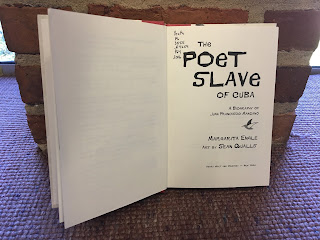The Poet Slave of Cuba
 The Poet Slave of Cuba
The Poet Slave of Cuba
Author: Margarita Engle
Illustrator: Sean Qualls
Genre: Poetry (Biography)
Major Awards: Pura Belpré
Grade Level: 4-12
Summary: This book is a collection of poems that serve as a biography of a man named Juan Francisco Manzano, who was born into slavery in Cuba. Manzano was promised freedom many times, but was always denied it. During his most haunting experiences, he relied on art, but when his art was taken away, he secretly learned to write poetry, using an eggshell as an inkwell and keeping them only to himself (page 63). Another interesting factor of this book is that it is the poems that tell the story are written from different viewpoints, including his owners, parents, and his new owners' (after his first died when he was eleven) son. These viewpoints provide a lot of insight into the difficult life that Manzano lived and makes his outlet of expression through words even more meaningful. He lived through many dark and haunting moments, which are portrayed through each poem in this book.
Evaluation: I personally really enjoyed this book. I found it very interesting that not only is it a biography told through poetry, but that it is written from many different viewpoints. I would not use this book in my class, however, because many of the themes are very dark and mature for young children. I would like to find a similar book, though, if one exists, to show my students that poetry serves many purposes and that creativity is limitless (i.e. a biography through poetry).
This book is really only appropriate for older readers, so I only included fourth through twelve. I think if a student in the fourth grade wants to read it and their parents are okay with them reading it, it is not my place to stop them, although I would never force them to read it for an assignment due to the mature/dark themes. The book is very powerful and the reader becomes emotionally invested, which is why it makes a great book for older students. It would be a great book to help them to fall in love with reading all over again.
As I said in the first paragraph, I would not use this in my classroom for young children. If I taught older grades, however, I think this would be a good book to teach that slavery did not/does not only exist in our country. It provides multicultural insight and allows us to compare our own history to the history of different countries and cultures.
Comments
Post a Comment